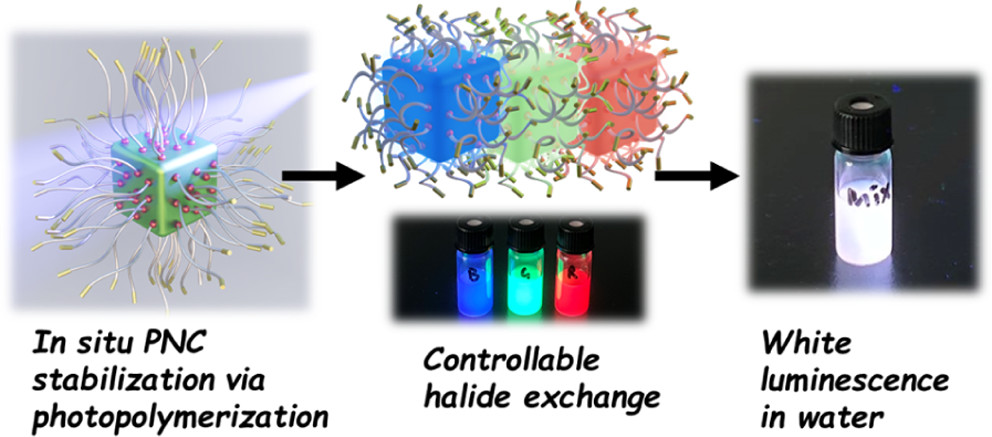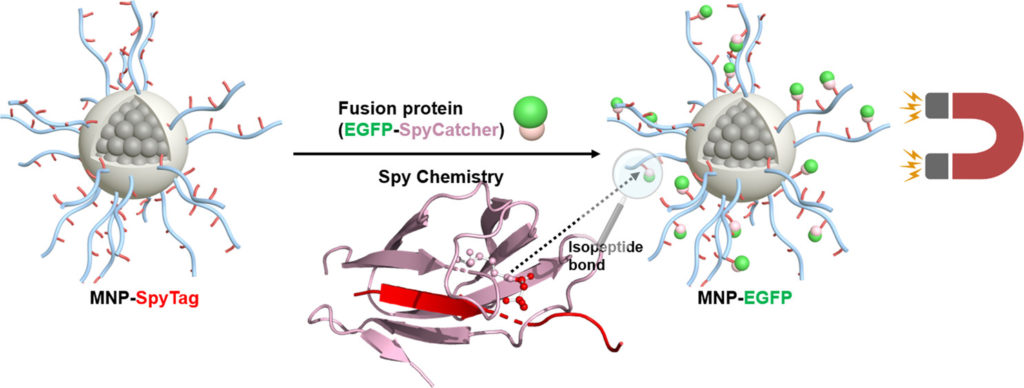1. Perovskite nanocrystal (PNC) catalyzed surface-initiated photopolymerization for stabilization of individual PNCs and regulation of their halide exchange behaviors.
Colloidal lead halide perovskite nanocrystals (PNCs) have demonstrated great potential as materials of light-emitting diodes if their colloidal and compositional instability could be addressed. We reported a facile surface-initiated photopolymerization method that introduced polymers on a CsPbBr3 PNC surface to achieve improved stability and regulated halide exchange of PNCs in polar solvents. Synthetic polymers grafted from the surface of an individual PNC surface stabilized the PNCs, in which the multidentate linkage initiators and the extending polymers were two essential factors. The polymer-grafted PNCs showed composition-dependent colloidal dispersity and structural stability in various polar organic solvents and aqueous condition. It was found that changing the polarity of dispersing solvents effectively switched the swelling and collapsed states of surface polymers on the PNC–polymer nanoparticles, which provided an on–off mechanism to regulate the permeation of halide anions into the PNC cores. This work provided insights into the rational functionalization of PNC materials using well-defined synthetic polymers toward tunable emission and outstanding stability in polar media.

Recent publication:
Xiuyu Jin, Kangling Ma, and Haifeng Gao. Tunable Luminescence and Enhanced Polar Solvent Resistance of Perovskite Nanocrystals Achieved by Surface-initiated Photopolymerization, J. Am. Chem. Soc. 2022, 144, 20411–20420.
Xiuyu Jin, Kangling Ma, Jishnudas Chakkamalayath, Janeala Morsby, and Haifeng Gao. In Situ Photocatalyzed Polymerization to Stabilize Perovskite Nanocrystals in Protic Solvents, ACS Energy Lett. 2022, 7, 610–616.
2. Magnetic nanoplatform with surface-tethered polymer brushes for selective enzyme immobilization based on Spy chemistry.
Immobilization of proteins on magnetic nanoparticles (MNPs) is an effective approach to improve protein stability and facilitate separation of immobilized proteins for repeated use. We exploited the efficient SpyTag-SpyCatcher chemistry for conjugation of functional proteins onto MNPs and established a robust magnetic-responsive nanoparticle platform for protein immobilization. To maximize the loading capacity and achieve outstanding water dispersity, the SpyTag peptide was incorporated into the surface-charged polymers of MNPs, which provided abundant active sites for Spy chemistry while maintaining excellent colloidal stability in buffer solution. Benefiting from the excellent water dispersity and interface compatibility, the surface Spy reaction has fast kinetics, which is comparable to that of the solution Spy reaction. The immobilization process of EGFP on MNPs was highly specific and robust, which was not affected by the presence of other proteins and detergents, such as bovine serum albumin and Tween 20. The MNP platform was demonstrated to be protective to the conjugated EGFP and significantly improved the shelf life of immobilized proteins. In addition, experiments confirmed the retained magnetophoresis of the MNP after protein loading, demonstrating fast MNP recovery under an external magnetic field. This MNP is expected to provide a versatile and modular platform to achieve effective and specific immobilization of other functional proteins, enabling easy reuse and storage.

Recent publications:
Quanhui Ye†, Xiuyu Jin†, Haifeng Gao and Na Wei. Site-Specific and Tunable Co-immobilization of Proteins onto Magnetic Nanoparticles via Spy Chemistry, ACS Appl. Bio Mater. 2022, Accepted (Front Cover).
Xiuyu Jin†, Quanhui Ye†, Chien-Wei Wang, Ying Wu, Kangling Ma, Sihan Yu, Na Wei, and Haifeng Gao. Magnetic Nanoplatform for Covalent Protein Immobilization Based on Spy Chemistry, ACS Appl. Mater. Interfaces. 2021, 13, 44147–44156.
3. Developed PNC encapsulation and passivation methods through swelling-shrinking strategy.
A robust polymer nanoparticle platform was developed for encapsulating PNCs in its interior for protection. The polymer nanoparticles were designed to have hydrophobic interior, crosslinked structure, 60 nm-300 nm in size and carry surface charges. These crosslinked nanoparticles that were synthesized in water and stabilized by surface charge could be dispersed in organic solvent in swollen state to load hydrophobic ligand coated PNCs without losing its colloidal structure. Subsequently, the nanoparticles could be phase transferred in aqueous media to collapse the interior and prevent the water permeation to destroy the PNCs. As the nanoparticles had both crosslinked interior and surface charges, this phase transfer between organic phase and water could be repeated with ease and robustness to load a mixture of PNCs to vary the emission color without affecting the final size and surface composition of the hybrid nanoparticles.
